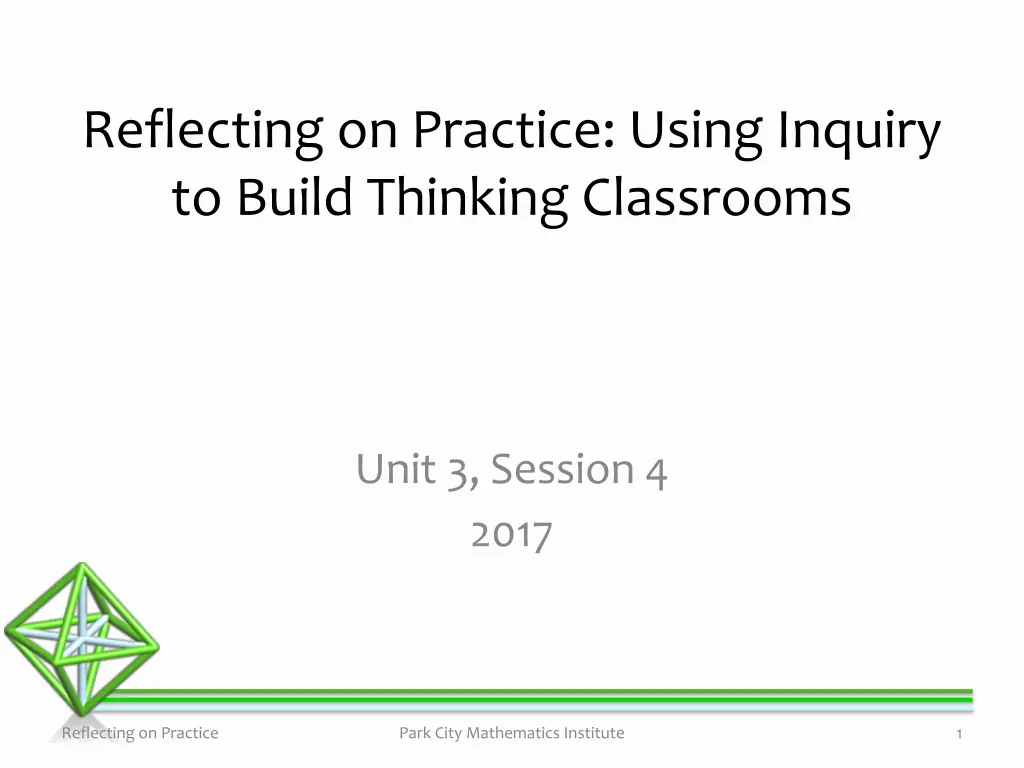
Building Math Thinking Classrooms: Reflecting on Inquiry Practices
Explore insights from sessions at the Park City Mathematics Institute on using inquiry to enhance thinking classrooms. Discover key elements such as effective communication strategies, teacher norms, and lesson planning scenarios that promote access, agency, and identity in mathematics education.
Download Presentation

Please find below an Image/Link to download the presentation.
The content on the website is provided AS IS for your information and personal use only. It may not be sold, licensed, or shared on other websites without obtaining consent from the author. If you encounter any issues during the download, it is possible that the publisher has removed the file from their server.
You are allowed to download the files provided on this website for personal or commercial use, subject to the condition that they are used lawfully. All files are the property of their respective owners.
The content on the website is provided AS IS for your information and personal use only. It may not be sold, licensed, or shared on other websites without obtaining consent from the author.
E N D
Presentation Transcript
Reflecting on Practice: Using Inquiry to Build Thinking Classrooms Unit 3, Session 4 2017 Reflecting on Practice Park City Mathematics Institute 1
Schoenfelds Presentation What resonated with you from his talk? 3
Mamadou Lesson In your folder, you have copies of Deborah Ball s goals for the Mamadou Half Rectangle lesson. Take a few minutes at your tables: What do you see in her goals that resonates with you with respect to access, agency and identify? Reflecting on Practice Park City Mathematics Institute 4
Reflecting on Practice Park City Mathematics Institute 5
Video Patty has large numbers of students who speak languages other than English in their homes. As a result, she emphasizes clear communication and presents sentence frames to support partners in their initial collaborations. On the third day of school, Patty distributes bags of unifix cubes and clues they use to collaboratively create a precise representation. 6
Table Group Talk Why do you think the teacher does this task on one of the first days of class? 8
Planning Activity 2 handouts: -TRU FRAMEWORK -Lesson Planning scenario On your vertical boards, record planning ideas for the three questions on the exponent handout. Use the TRU framework handout as a guide. 9
Norms for students Take turns Listen to others ideas Disagree with ideas not people Be respectful Helping is not the same as giving answers Confusion is part of learning Say your becauses I can t do that yet Horn, 2012
Norms for teachers Listen for what can be learned about students' thinking rather than for correct answers Identify & check a hinge point in the lesson where student understanding is critical for moving on No hands up, except to ask a question Leahy et al, 2005 Be relentless in asking what does it mean/why it works Maintain neutral stance with respect to answers Record responses so everyone can think about them Wait time before responses/after response Deflect questions to students- Never say anything a kid can say Plan, plan, plan questions/discussion in advance Burrill, 2013
References Boaler, J. & Humphreys, C. (2005). Connecting Mathematical Ideas. Heinemann Horn, L. (2012). Strength in numbers: Collaborative learning in secondary mathematics. Reston VA: National Council of Teachers of Mathematics. National Research Council (2002), Growing dots. In H. Bass, H., Z. Usiskin, Z, & G. Burrill (Eds.) Classroom practice as a medium for professional development. Washington, DC: National Academy Press. TIMSS Video Study. (2003). National Center for Education Statistics (NCES). Third International Mathematics and Science Study. US2. Writing variable expressions. US 3 Exponents http://www.timssvideo.com/videos/mathematics/United%20States TRU Framework Reflecting on Practice Park City Mathematics Institute 12
